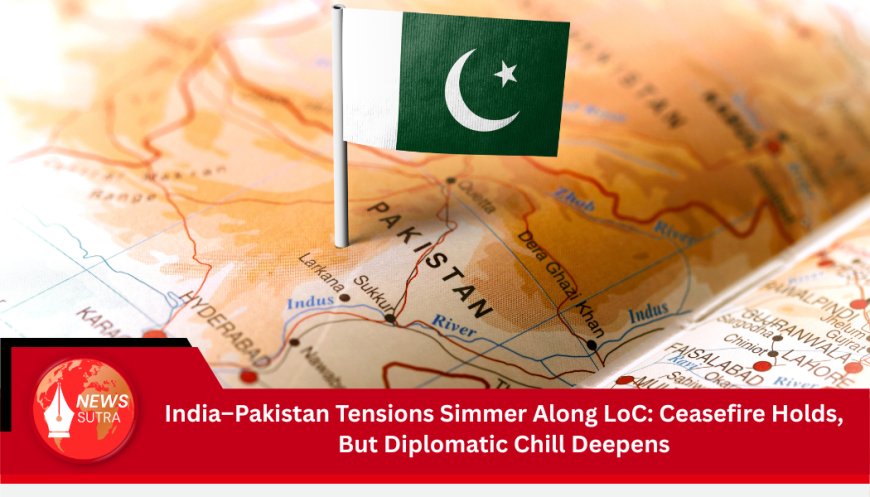India–Pakistan Tensions Simmer Along LoC: Ceasefire Holds, But Diplomatic Chill Deepens
India and Pakistan remain locked in a diplomatic freeze despite a ceasefire at the LoC. Military posturing and stalled talks raise fears of long-term instability.

By Ronald Kapper | June 13, 2025
The Line of Control (LoC) between India and Pakistan remains tense following weeks of heightened military alertness, sporadic troop movement, and a diplomatic freeze that shows little sign of thawing. While the formal ceasefire agreement signed in February 2021 technically remains in effect, both nations have hardened their positions after a series of security incidents and political escalations in recent months.
Background: A History of Fragile Peace
The LoC, which divides Indian-administered and Pakistan-administered Kashmir, has been a flashpoint for conflict since the partition of British India in 1947. The February 2021 ceasefire agreement, brokered through backchannel talks and later confirmed by both India’s Ministry of External Affairs (MEA) and Pakistan’s Inter-Services Public Relations (ISPR), brought rare calm to the border region.
However, recent events have reignited tensions. In April 2025, a coordinated terror attack in Pahalgam, Jammu and Kashmir, which left nine civilians dead, was widely attributed by Indian security agencies to cross-border infiltrators allegedly supported by Pakistan-based terror groups. The Pakistani government denied any involvement, but the incident led to the suspension of semi-official communication channels.
Escalation Without Firepower: The New Cold Standoff
Despite the absence of open hostilities, both nations have increased military readiness across key sectors of the LoC. Satellite imagery reviewed by The Diplomat and independent OSINT analysts shows additional troop deployments and heightened aerial surveillance by both countries.
Additionally, several infrastructure and defense upgrade projects are underway on the Indian side. According to IDSA India, road widening and advanced bunker construction have been accelerated in sectors like Uri, Rajouri, and Poonch.
While no direct artillery exchanges have been reported since February, local residents in border villages have spoken of increased military patrols, night-time drills, and restricted civilian movement—a sign that both armies are maintaining a “high alert” posture.
Diplomatic Freeze: No Talks, No Trade, No Treaties
The political dimension of the standoff is equally bleak. There has been no high-level diplomatic engagement between New Delhi and Islamabad since early 2024, and several confidence-building measures (CBMs), including the Indus Waters Treaty cooperation, have slowed or halted entirely.
India maintains that meaningful talks can only occur if Pakistan takes “verifiable and irreversible action” against terror groups operating from its soil. Pakistan, meanwhile, has accused India of “human rights violations” in Kashmir and demands international mediation—something India categorically rejects.
The recent withdrawal of Most Favoured Nation (MFN) status and the prolonged suspension of cross-LoC trade and travel routes, such as those via the Salamabad–Uri and Chakan Da Bagh–Rawalakot corridors, have further widened the diplomatic chasm. Carnegie India noted in a recent report that the current impasse represents "the longest freeze in bilateral diplomacy since the Kargil War of 1999."
Regional and Global Implications
The continued chill between the two nuclear-armed neighbors raises concerns not only for regional peace but also for broader geopolitical stability. With both countries possessing second-strike nuclear capabilities, even low-scale military miscalculations can have devastating consequences.
The United Nations Department of Political and Peacebuilding Affairs (UN DPPA) has called for "maximum restraint" and urged both nations to resume dialogue. However, New Delhi remains skeptical of any third-party involvement in what it considers a bilateral issue.
Interestingly, the recent escalation between Israel and Iran has drawn parallels among strategic analysts. Brookings Institution recently highlighted how localized disputes—when unmanaged—can quickly entangle larger powers and shift regional balances.
Media and Civilian Voices Silenced
On the ground, local journalists and human rights workers have found it increasingly difficult to report from LoC-adjacent regions. Several independent reporters in Jammu and Kashmir have spoken about pressure to avoid stories that could “alarm” the public or “complicate national security efforts.”
Civilian life in border districts continues under uncertainty. Schools near LoC sectors operate under constant threat of sudden closure, while agricultural activities—critical to the local economy—have suffered due to restricted land access and increased troop presence.
Looking Ahead: Is There Any Path to Dialogue?
Experts suggest that both sides may be holding off any escalation until after India's 2026 general elections. With political stakes high, neither government wants to appear weak on national security. That said, quiet diplomacy, often conducted through third-party channels such as the UAE or Saudi Arabia, has previously helped de-escalate similar impasses.
There is also talk of reactivating the Director Generals of Military Operations (DGMO) hotline, which has been silent for months. If successful, such military-to-military contact could lay the groundwork for broader talks.
Conclusion
For now, the India–Pakistan relationship remains frozen in a state of wary watchfulness. The absence of gunfire should not be mistaken for peace. As long as the underlying issues of terror, sovereignty, and mutual distrust remain unaddressed, the LoC will continue to serve as both a literal and symbolic line of division.














